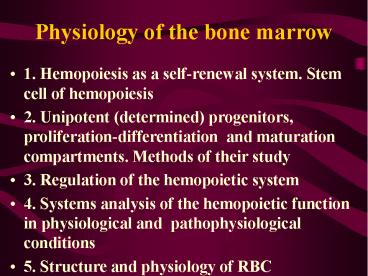Physiology of the bone marrow - PowerPoint PPT Presentation
Title: Physiology of the bone marrow
1
Physiology of the bone marrow
- 1. Hemopoiesis as a self-renewal system. Stem
cell of hemopoiesis - 2. Unipotent (determined) progenitors,
proliferation-differentiation and maturation
compartments. Methods of their study - 3. Regulation of the hemopoietic system
- 4. Systems analysis of the hemopoietic function
in physiological and pathophysiological
conditions - 5. Structure and physiology of RBC
2
1. Hemopoiesis as a self-renewal system.
Stem cell of hemopoiesis A self-renewal system
loses mature (functional) cells steadily and
replaces them continually. Normally it is
composed of three cellular compartements
- pluripotent stem cells which are
capable of - non declining
(steady) autoreproduction -
differentiating into various developmental
lines (pluripotentiality)
- unipotent cells capable of dividing
proliferation) - differentiated
functional (postmitotic) cells
unable of division Blood forming organs represent
a typical example of a self-renewal system (Fig.
1).
3
1
4
All non-stem populations are transitory. The
transit times in the individual compartements
Two types of damage - loss of mature
cells (e.g., bleeding, inflammation) -
damage to the stem cell and precursor
compartement (e.g., radiation,
cytotoxic drugs) Lymphatic organs are totally
dependent on the marrow
5
Fig 2 Erythropoiesis, the development and
maturation of the red blood cells
2
6
2. Unipotent (determined) progenitors,
proliferation-differentiation and maturation
compartments. Methods of their study The
historically first method of the stem cell
detection colony forming units spleen
(CFU-S) Fig. 3, Fig. 4 The stages which cannot
be differentiated morphologically
are detected by means of short-
term colonies in vitro
7
3
8
4
9
Besides, the stem and precursor cells could be
identified by means of flow cytometry (? numbers
of different cells) and light-activated cell
sorting (? preparing of homogenous cell
populations, Fig. 5)
10
5
11
1. Regulation of the hemopoietic system
Fig. 6 Hemopoietic inductive microenvironment
(HIM) - fibroblast-type reticulum
cell granulopoietic islands -
macrophage-type reticulum cell erythroblastic
islands
6
12
Cytokines peptides taking part in the
signalling among the immune and hematopoietic
system cells. No hormones (endocrine). Types
- Interleukins (Il-1, 2,...etc.) MF, T
cells, stromal cells (HIM)? growth and
differentiation of - lymphocytes
- hematopoetic stem cells (some of them
are known as colony stimulating
factors, CSF) Ils taking part in steady-state
hemopoiesis - multi-CSF ( Il-3) from
helper T-cells - GM-CSF - Il-6
- Il-7 (development of B- and T-lymphocytes)
13
In non-steady-state-conditions production
of a number of growth factors more
specific in their actions which are usually
produced by activated blood cells or
fibroblasts Il-4 and Il-9 (production of
basophils and mast cells), Il-5
(eosinophils), G-CSF, M-CSF, EPO -
Interferons induced in response to a variety of
agents including viruses,
microorganisms and endotoxins. Upon
induction, they circulate to
neighboring cells which they stimulate to make
antiviral proteins
14
- Lymphokines Proteins secreted by some helper
T
cells after they are primed by contact with an
antigen. Are not antibodies but are mediators
of cellular immunity. They activate various
white blood cells, incl. other lymphocytes.
Examples interleukin 2, some interferons,
migration inhibition factor (MIF) - Tumor necrosis factors have cytotoxic effects
on tumor cells but not on normal cells. TNF? is
secreted by macrophages in response to
bacterial infection and other challenges, TNF?
by helper T lymphocytes and cytotoxic
lymphocytes. Synergistic with interferons
15
4. Systems analysis of the hemopoietic function
in physiological and pathophysiological
conditions The homeostasing of the blood cell
production is regulated by several feedbacks.
Their interplay may be rather complex and can be
understood by means of mathematical modelling
only (Fig. 7, 8, 9)
16
7
17
8
18
9
19
5. Structure and physiology of RBC The
RBS have lost - mitochondria, citric acid cycle
and oxydative phosphorylation forming
ATP ? anaerobic glycolysis must be the
main source of ATP in them -
ribosomes ? no protein synthesis, detrition of
enzymes etc. RBC membrane
Fig. 10 glycophorins can attach lectins
phytohemagglutinins, viruses and malaria parasites
20
10
21
Fig. 11a, b Spectrin and actin ? filamentous
network responsible for the biconcave shape of
RBC ankyrin links spectrin molecules to
anion-transport proteins (band 3)
22
11a
23
11b
24
Hemoglobin protection against oxidation (Fig.
12)
12
25
RBC shape and its life span (Fig. 13)
)
13































